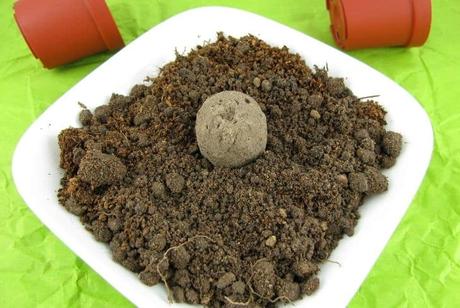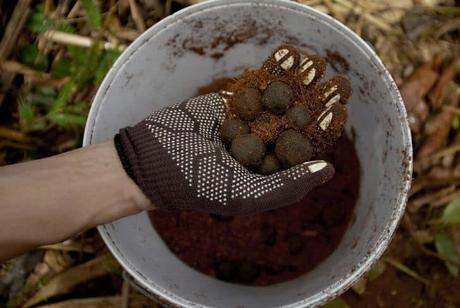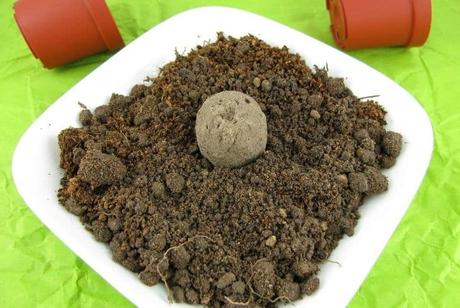What are Seed Balls?
Every plant you know, started somewhere, either as a cutting or as a seed or any other form. Seeds are the final product of a plant and are the beginning of life for another. Their mode of distribution varies, with some being manually planted, with others being migrated by humans or other birds and animals, and others being dispersed off by air.
Seed balls are uniquely made to be dispersed off in a bit of a controlled manner and give life to new plants. This article discusses seed balls in detail, particularly understanding what seed balls are, how to make them, how they work, what they are used for, and a few facts about them.

Seed balls or seed bombs are seeds that have been wrapped in soil matter and then dried. The soil matter is often a mixture of clay and compost. The seed is, therefore, pre-planted and can be sown by depositing the seed ball anywhere as long as the species can survive there. The wrapping mixture keeps the seed safe until it can properly germinate.
Seed balls are one of the easiest and sustainable ways of cultivating plants to win a manner that avails a larger window of time until the sowing window comes. Seed balls are also the best and most convenient way of dispersing seeds for guerrilla gardeners as well as those with achy backs.
With seed balls, you can propagate plants and trees from seeds, without the need for opening the soil with cultivation tools like a plow. Seed balls were rediscovered and popularized by a Japanese farmer, philosopher, microbiologist and agriculturalist, Masanobu Fukuoka in the early twentieth century.
Like many other farmers, Fukuoka believed that tilling over a large area for cultivation is laborious, destroys the health of the soil and is a waste of time and energy and therefore not necessary. As such, seed balls became an important aspect of natural farming and conservation enterprises all over the world. The practice of seed balls was very effective in growing rice, barley, vegetables and fruits.
Seed balls are synonymous anywhere there is land for cultivation. They are an effective way of establishing plants without the need for plowing or drilling, at very little cost. They are also very common in urban areas where tilling is not an option.
Seed balls have been employed to establish perennial pastures on marginal degraded highlands where the use of seed-drills and rippers is impossible because of steep slopes, existing woodlands, shallow soils/exposed bedrock, and general rockiness of the area.
How to Make Seed Balls?
1. Preparation
Seed balls are made from mixing clay, compost and seeds. You, therefore, need these three basic materials. They have to be processed and the clay and compost have to be relatively fine-textured, and that the seeds are winnowed, removing casings and hulls.
Pulverizing and screening the clay will remove rocks, vegetation and stubborn clod materials. The compost also needs to be relatively sifted. Any compost can do, but the more biologically active the compost, the better and inoculant the seed balls will be.
2. Additions
You can also choose to add other elements, depending on the circumstances and the desired outcome. For instance, you may choose to add compounds found in capsicum, artemia, black pepper, mints and alliums, as they deter insects from opening the balls and eating the seed.
3. Ingredients
You need 5 parts pottery clay mix, 2 parts potting soil, 1-2 parts water, and 1-2-part seeds of your choosing. You will also need a large tub to mix the ingredients and a large box to dry and store the seed balls
4. Directions
First, you will mix the soil, clay, compost and 1-part water thoroughly. You should ensure there are no lumps. Slowly add more water until the mixture is consistent. Next, you will add the seeds. Keep kneading the dough until the seeds are well mixed in. if necessary, add more water.
Then, take small bits of the clay mixture and roll into a ball about one inch in diameter. The balls should hold together easily and if they are crumbling, add more water. With the balls rolled, place them in a large box and let them dry for 24-48 hours in a shady place.
You will then move them into a cardboard box for storage. Never store them in plastic bags. Finally, sow them by either placing them over the area to be planted or toss them one at a time. The tossing part is fun and you can get as creative as you want. Do not bury them and neither should you water them.
How Do Seed Balls Work?
1. The dried clay shell
It protects the seed from common predators such as mice, birds and ants, as well as harsh sun. It keeps the seed in protective care until it starts germinating. By then, it will crack and be rendered useless.
2. The ball
During germination, the ball itself will contain nutritious minerals or humus, which helps the seed germinate.
3. The chili powder or compounds
They have a strong odor that deters predators as the seed ball slowly degrades and the seed continues to sprout.
4. The seed
The seed will germinate given the conditions are favorable and is native to the area. when sufficient rain permeates the clay casing, the seed will germinate
5. Sowing
When planting trees the conventional way, you have to dig holes and source for an already germinated tree seedling, which is about one inch tall. It is a fun experience but it is tedious. With seed balls, you do not need to water, or pit holes for planting them. You only need to make them and then scatter them in an open field, and with time, they will germinate and grow into big trees.
6. Practice patience
They do not germinate immediately. They require some patience, although it is a highly rewarding project.
7. Storing
You do not need to scatter them immediately after they have dried up. If placed in a cool and dry place, seed balls can be stored and be suitable for planted for a couple of years.

Uses of Seed Balls
1. Reforesting an area
Through the ability possessed by seed balls, it is possible to reintroduce tree species that have partly or completely been removed from their original environments. All you need is those species’ seeds, and make them into seed balls, before deploying them into the environment. They will then grow into mature trees and be successful in improving their numbers within the area
2. Planting wildflowers
Seed balls can also be used to grow wildflowers. These flowers are vital during pollination by bees.
3. As a teaching source for kids
it is fun to undertake some projects with your children. Making seed balls is one of those projects where they can absolutely learn something new. in addition to making the seed balls themselves, they can also test their throwing strength b tossing the balls as far as they can. It is a bonding session, and will eventually help the environment.
4. They have additional purposes, especially preservation
In the Carolinas, in the 1700s, West African women slaves could cultivate rice using the seed ball technique, which they were practicing in Africa. Rice seeds were coated in clay, dried and pressed in the mudflats with the heel of their feet. Apart from protecting the grain from birds, the seed ball protected it from floating away once the fields were flooded. It is actually a perfect way of planting plants that would otherwise be disturbed while in the germination or pre-germination period by natural forces or predators.
5. Enriching the landscape
Seed balls can be used to enrich a neglected area, like roadsides as well as abandoned lots, thereby enhancing the biodiversity of plants or vegetation. The balls provide a flourishing atmosphere to the seed and as soon as it breaks from the ball, the minerals present in the ball will continue to serve the surrounding area, enriching it than before.
Facts About Seed Balls
1. They are easy to make
Seed balls are incredibly easy to make. All you need is soil or compost, seeds and clay. The seeds have to be native to the region or can grow in the region, otherwise, they will not germinate. Also, non-native species might disturb the local balance and introduce invasive species. Next, take five-parts soil and three parts clay, with one seed. The end product should be about the size of a quarter so that they can be easily thrown or dispersed. To maximize the seeds’ chances of sprouting roots, deploy them in the summer or spring.
2. Seed balls have existed for a very long time
The technology of seed balls first arose in ancient Egypt, where they were used to restore farmlands after the Nile’s annual spring flood. They were also referred to in Japan as tsuchi dango, or ‘earth dumplings’ and the practice was revived by Masanobu Fukuoka. The practised was incorporated into guerrilla gardening in the 1970s, and the movement sought to rehabilitate derelict or neglected urban land through direct action.
3. Seed balls are versatile
They can be tossed over fenced into abandoned land, or out through the windows of cars onto roadside wasteland. They can be left on parking lots and bike paths and unused gardens and they will grow from there. They can go where no one else can. As long as there is land for them to grow, and is not too dry, compact or dense with other vegetation, seed balls will flourish.
4. Seed balls are diverse
You can literally use any seed in your seed balls. You can try wildflower seeds, which are vital for pollination, herbs, edible crops or even trees. You can also put a combination of seeds, especially companion plants which grow well together, assisting in pollination, soil conditioning and the deterrence of pests.
5. Seed balls get people involved
It is satisfying to plant and help the environment in growing. There are thousands of non-governmental organizations all over the world, dedicated to planting trees, for instance, and they heavily rely on the input of others. Planting trees, although satisfying, is hard work as it requires pitting holes, clearing weeds, watering and pruning. Additionally, you need permission to plant trees on land belonging to others.
However, with seed balls, all you need to do is have the seed balls in your possession and throw them. They do not require the pitting, weeding or the permission required by planting tree seedlings. It can, therefore, get everyone involved, including people of all races, ages and classes, even if they are not gardeners themselves.
6. Seed balls can be stored for years
If kept in a cool and dry place, seed balls can be stored and be suitable for planted for a couple of years.
References:
“5 Cool Facts About Seed Balls”. (2019). Student Conservation Association. Retrieved from https://www.thesca.org/connect/blog/5-cool-facts-about-seed-balls
“HOW DO SEED BALLS WORK?”. (2014). Rutland Horticulture. Retrieved from http://rutlandhorticulture.co.uk/blog/how-do-seed-balls-work/
“What are Seed Balls?”. SeedBalls.com. Retrieved from https://seed-balls.com/what-are-seed-balls
Schreiber, A. (2014). Making Seedballs: An Ancient Method of No-till Agriculture. Permaculture Research Institute. Retrieved from https://www.permaculturenews.org/2014/06/18/making-seedballs-ancient-method-till-agriculture/
Teklu, H. (n.d.). YALI Voices: How to Make Seed Balls. YALI. Retrieved from https://yali.state.gov/yali-voices-how-to-make-seed-balls/


